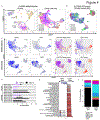YAP1 Status Defines Two Intrinsic Subtypes of LCNEC with Distinct Molecular Features and Therapeutic Vulnerabilities
- PMID: 39150543
- PMCID: PMC11479841
- DOI: 10.1158/1078-0432.CCR-24-0361
YAP1 Status Defines Two Intrinsic Subtypes of LCNEC with Distinct Molecular Features and Therapeutic Vulnerabilities
Abstract
Purpose: Large cell neuroendocrine carcinoma (LCNEC) is a high-grade neuroendocrine malignancy that, like small cell lung cancer (SCLC), is associated with the absence of druggable oncogenic drivers and dismal prognosis. In contrast to SCLC, however, there is little evidence to guide optimal treatment strategies, which are often adapted from SCLC and non-small cell lung cancer approaches.
Experimental design: To better define the biology of LCNEC, we analyzed cell line and patient genomic data and performed IHC and single-cell RNA sequencing of core needle biopsies from patients with LCNEC and preclinical models.
Results: In this study, we demonstrate that the presence or absence of YAP1 distinguishes two subsets of LCNEC. The YAP1-high subset is mesenchymal and inflamed and is characterized, alongside TP53 mutations, by co-occurring alterations in CDKN2A/B and SMARCA4. Therapeutically, the YAP1-high subset demonstrates vulnerability to MEK- and AXL-targeting strategies, including a novel preclinical AXL chimeric antigen receptor-expressing T cell. Meanwhile, the YAP1-low subset is epithelial and immune-cold and more commonly features TP53 and RB1 co-mutations, similar to those observed in pure SCLC. Notably, the YAP1-low subset is also characterized by the expression of SCLC subtype-defining transcription factors, especially ASCL1 and NEUROD1, and as expected, given its transcriptional similarities to SCLC, exhibits putative vulnerabilities reminiscent of SCLC, including delta-like ligand 3 and CD56 targeting, as is with novel preclinical delta-like ligand 3 and CD56 chimeric antigen receptor-expressing T cells, and DNA damage repair inhibition.
Conclusions: YAP1 defines distinct subsets of LCNEC with unique biology. These findings highlight the potential for YAP1 to guide personalized treatment strategies for LCNEC.
©2024 American Association for Cancer Research.
Conflict of interest statement
L.A.B received consulting fees and research funding from AstraZeneca, GenMab, Sierra Oncology, research funding from ToleroPharmaceuticals and served as advisor or consultant for PharmaMar, AbbVie, Bristol-Myers Squibb, Alethia, Merck, Pfizer, Jazz Pharmaceuticals, Genentech, and Debiopharm Group. C.M.G. is a member of the advisory board at Jazz Pharmaceuticals, AstraZeneca, and Bristol Myers Squibb and served as speaker for AstraZeneca and BeiGene.
Figures






References
MeSH terms
Substances
Grants and funding
- U01 CA213273/CA/NCI NIH HHS/United States
- U01-CA213273/National Cancer Institute (NCI)
- RP210028/Cancer Prevention and Research Institute of Texas (CPRIT)
- T32-CA009666/National Cancer Institute (NCI)
- 2020-02/LUNGevity Foundation (LUNGevity)
- P50 CA070907/CA/NCI NIH HHS/United States
- R01-CA207295/National Cancer Institute (NCI)
- T32 CA009666/CA/NCI NIH HHS/United States
- P30-CA016672/National Cancer Institute (NCI)
- U01 CA256780/CA/NCI NIH HHS/United States
- P30 CA016672/CA/NCI NIH HHS/United States
- R50-CA243698/National Cancer Institute (NCI)
- U24 CA213274/CA/NCI NIH HHS/United States
- Moon Shot Program/University of Texas MD Anderson Cancer Center (MD Anderson)
- U24-CA213274/National Cancer Institute (NCI)
- Neuroendocrine Tumor Research Foundation (NETRF)
- P50-CA070907/National Cancer Institute (NCI)
- R50 CA243698/CA/NCI NIH HHS/United States
- Rexanna's Foundation (Rexanna Foundation for Fighting Lung Cancer)
- S10 OD024977/OD/NIH HHS/United States
- LC210510/U.S. Department of Defense (DOD)
- R01 CA207295/CA/NCI NIH HHS/United States
- RP180684/Cancer Prevention and Research Institute of Texas (CPRIT)
LinkOut - more resources
Full Text Sources
Medical
Molecular Biology Databases
Research Materials
Miscellaneous

